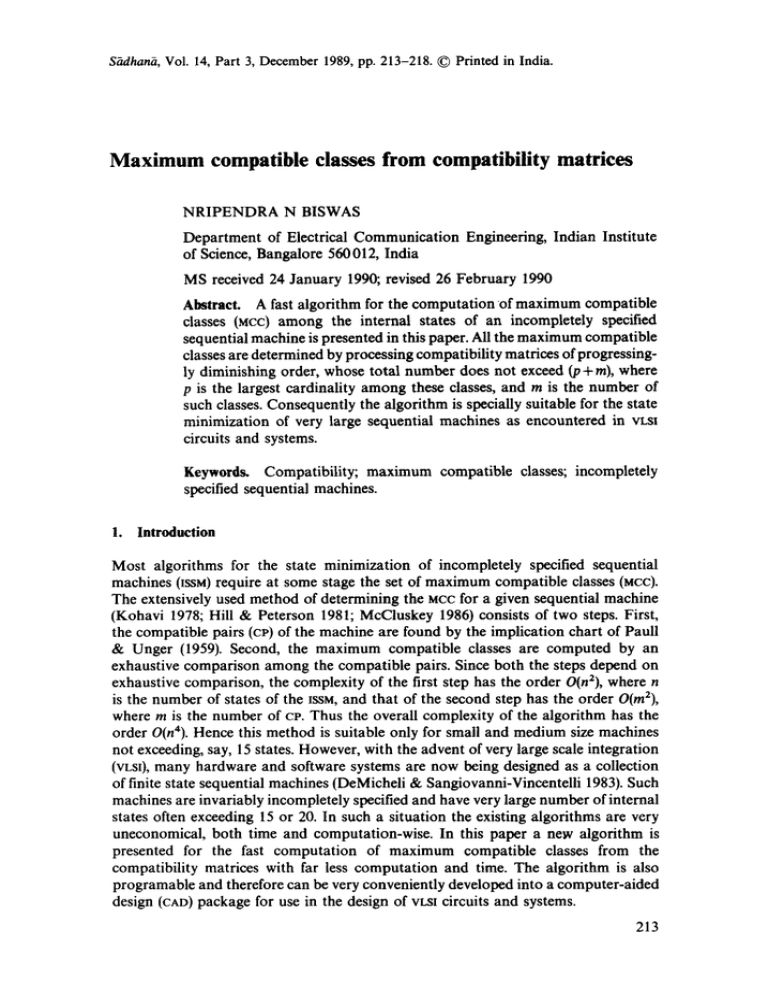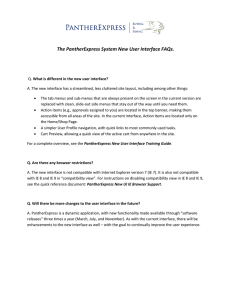Maximum compatible classes from compatibility matrices S~dhan{t,
advertisement

S~dhan{t, Vol. 14, Part 3, December 1989, pp. 213-218. © Printed in India.
Maximum compatible classes from compatibility matrices
NRIPENDRA N BISWAS
Department of Electrical Communication Engineering, Indian Institute
of Science, Bangalore 560012, India
MS received 24 January 1990; revised 26 February 1990
Abstract. A fast algorithm for the computation of maximum compatible
classes (Mcc) among the internal states of an incompletely specified
sequential machine is presented in this paper. All the maximum compatible
classes are determined by processing compatibility matrices of progressingly diminishing order, whose total number does not exceed (p + m), where
p is the largest cardinality among these classes, and m is the number of
such classes. Consequently the algorithm is specially suitable for the state
minimization of very large sequential machines as encountered in VLSl
circuits and systems.
Keywords. Compatibility; maximum compatible classes; incompletely
specified sequential machines.
1. Introduction
Most algorithms for the state minimization of incompletely specified sequential
machines 0SSM)require at some stage the set of maximum compatible classes (MCC).
The extensively used method of determining the MCC for a given sequential machine
(Kohavi 1978; Hill & Peterson 1981; McCluskey 1986) consists of two steps. First,
the compatible pairs (cv) of the machine are found by the implication chart of Paull
& Unger (1959). Second, the maximum compatible classes are computed by an
exhaustive comparison among the compatible pairs. Since both the steps depend on
exhaustive comparison, the complexity of the first step has the order O(n2), where n
is the number of states of the ISSM,and that of the second step has the order O(m2),
where m is the number of cP. Thus the overall complexity of the algorithm has the
order O(n4). Hence this method is suitable only for small and medium size machines
not exceeding, say, 15 states. However, with the advent of very large scale integration
(VLS0, many hardware and software systems are now being designed as a collection
of finite state sequential machines (DeMicheli & Sangiovanni-Vincentelli 1983). Such
machines are invariably incompletely specified and have very large number of internal
states often exceeding 15 or 20. In such a situation the existing algorithms are very
uneconomical, both time and computation-wise. In this paper a new algorithm is
presented for the fast computation of maximum compatible classes from the
compatibility matrices with far less computation and time. The algorithm is also
programable and therefore can be very conveniently developed into a computer-aided
design (CAD)package for use in the design of VLSXcircuits and systems.
213
214
Nripendra N Biswas
2. The algorithm
In describing the algorithm, the frequently used terms, such as, incompletely specified
sequential machine (ISSM), compatibility, compatible pair (ce) and maximum cfmpatible
class (Met) will be assumed to have their usual definitions as given in books on
switching theory and logical design (Kohavi 1978; Hill & Peterson 1981). We shall
develop the algorithm by working out an example. Like other algorithms here also
the compatibility relations between all pairs of states are determined by the implication
chart. This compatibility relation is then depicted in the form of an n × n matrix where
n is the number of states of the ISSM. The rows and columns of the matrix are the
states of the machine. A 1(0) is written at the intersection of a row and column when
the corresponding pairs of states is compatible (incompatible). Table 1 shows the
compatibility matrix CMt of a 9-state ISSMshowing the compatibility relations between
all pairs as obtained from the implication chart. Note that the compatibility matrix
¢Mt is a symmetric matrix with an all-1 leading diagonal. This is so because each
state is compatible with itself. In table 1 two more columns are added to ¢M~. The
two additional columns give the weight (~) and candidate maximum compatible class
(CMCC) of each row, which are defined below.
DEFINITION 1
The number of ones in a row will be called its weight.
It will be designated by a.
Again each row of the other additional column gives the collection of all states
which are compatible with the state heading the row. Thus in table 1 each of the
states among ABCDHI is compatible with state A, and each of the states BCDEH
is compatible with the state E.
DEFINITION 2
The collection of states which are compatible with a state will be called a candidate
maximum compatible class (CMCC). The state with which each of the states of a cMcc
is compatible will be called the generating state of the CMCC.
Thus every state of the machine, that is, every row of the CM1 generates a CMCC.
It is also obvious that each MCC is either a CMCC itself or a subset of a CMCC. The
algorithm finds all the maximum compatible classes of the IssM from these candidate
classes with the help of the following theorems and corollaries.
Table 1. Compatibility matrix (c}~t).
A
B
C
D
E
*F
G
H
I
A
B
C
D
E
F
G
H
I
a
CMCC
1
1
1
1
0
0
0
1
1
1
1
1
1
1
0
1
1
1
1
1
1
0
1
0
1
1
0
1
1
0
1
1
0
0
1
1
0
1
1
1
1
0
0
1
0
0
0
0
0
0
1
1
0
0
0
1
1
0
0
1
1
0
0
1
1
1
1
1
0
0
1
1
1
1
0
1
0
0
0
1
1
6
8
6
6
5
2
4
7
5
ABCDHI
ABCDEGHI
ABCEGH
ABDEHI
BCDEH
FG
BCFG
ABCDEHI
ABDHI
Maximum compatible classes from compatibility matrices
215
Theorem 1.
A candidate maximum compatible class is a maximum compatible class if
and only if it is one of the least cardinality cMcc among all the CMCCs and all its
constituent states are pairwise compatible.
Proof. If(Sufficiency): If all the constituent states of a CMCC are pairwise compatible
then the CMCC is an MCC if it is not contained in a larger MCC. Now, since the CMCC
has the least cardinality, the generating state of the CMCC has all its compatible states
included in the CMCC and therefore there can be no MCC with greater cardinality
which may contain the generating state within it. Therefore the CMCC cannot be
contained in another larger MCC. Hence the CMCC is an MCC.
O N L Y IF (Necessity):
It is obvious that the two conditions which are sufficient are
also necessary to make a cMcc an MCC.
QED
Note that all the elements of the compatibility matrix of an MCC are ones.
C O R O L L A R Y . 1.1
A CMCC of cardinality 1 or 2 is an MCC.
The proof of this corollary is obvious.
Theorem 2. A CMCC with the least cardinality which is itself not an MCC will generate
more than one MCC with the generating state as one of its members. Each MCC produces
an all-1 matrix, and its columns (or rows)form a subset of the CMCC which is not
contained in a larger subset.
Proof.
The CMCC with the least cardinality fails to become an MCC only when one
(or more) pairs in it is (are) not compatible. Therefore, each of the subsets which
produces an all-1 matrix has all its states pairwise compatible. Since the subset is not
contained in a larger subset, it is an MCC.
QED
C O R O L L A R Y . 2.1
I f there are two and only two zeros in the subcompatibility matrix of a CMCC, then
the CMCC produces two maximum compatible classes.
Proof. If the element aii of a subcompatibility matrix (scM) is a 0, then the element
aji will also be a 0, since the SCM is a symmetric matrix. Now, this pair of zeros can be
eliminated from the scM in two ways, by deleting either the row and column i or the
row and column j. Hence, the scM will produce two all-1 submatrices and, therefore,
two MCCS.
QED
If the scM of a cMcc has more than two zeros, then find all the Mcc by following
the generalized procedure as applied to a CM.
Theorem 3. After all maximum compatible classes contained in a CMCC have been
determined, the generating state of the CMCC can be deleted from the rest of the candidate
maximum compatible classes.
Proof.
A cM¢c has all the states which are compatible with its generating state.
216
Nripendra N Biswas
Compatibility matrix
Table 2.
A
B
C
D
E
*G
H
I
(CM2)
A
B
C
D
E
G
H
I
a
1
1
1
1
0
0
1
1
1
1
1
1
1
1
1
1
1
1
1
0
1
1
1
0
1
1
0
1
1
0
1
1
0
1
1
1
1
0
1
0
0
1
1
0
0
1
0
0
1
1
1
1
1
0
1
1
1
1
0
1
0
0
1
1
6
8
6
6
5
3
7
5
CMCC
BCG
Therefore, all maximum compatible classes having the generating state in it are
determined from the CMCC, and there cannot be any other MCC which may have the
generating state in it. Hence the theorem.
QED
To apply theorem 1 to CM1 of table 1, first the CMCC of the least cardinality is
chosen. In this case it is the CMCC F G generated by the state F of the ISSMand it has
a cardinality of 2. By corollary 1.1 F G can be listed as an u c c without any further
processing. Once F G is selected as an MCC, the row and column of state F are deleted
from CMI as a direct consequence of theorem 3.
This is how CM2 (table 2) is derived from CM1.
Note that while CM1 was a matrix of order 9, CMz becomes a matrix of a reduced
order, namely, 8. Again applying theorem 1 to CM2 the CMCC BCG generated by the
state G has the least cardinality. In order to check if the CMCC is an MCC, a submatrix
with B, C and G as rows and columns is derived from CM2. This is called the
subcompatibility matrix SCM2 (BCG) and is shown in table 3. Obviously all the states
will be pairwise compatible, if the submatrix is an all-1 matrix. It can be seen that
the submatrix SCM2(BCG) is an all-1 matrix, as all the row weights are 3. Hence, by
theorem 1, BCG is an MCC. After BCG is selected as an MCC, state G is deleted from
the rows and columns of CM2, and CM3 as shown in table 4 is obtained.
Table 3. Subcompatibility matrix
SCM2 (BCG).
B
C
G
Table 4.
C
G
a
1
1
1
1
1
1
1
1
1
3
3
3
Compatibility matrix (CM3).
A
A
B
*C
D
*E
H
*1
B
!
I
1
!
0
I
I
B
C
D
E
H
I
a
!
!
1
0
1
l
0
1
1
0
1
1
1
1
0
1
1
I
1
1
0
1
1
1
1
1
1
1
1
1
0
1
0
1
1
6
7
5
6
5
7
5
CMCC
ABCEH
BCDEH
ABDHI
Maximum compatible classes from compatibility matrices
217
Table 5. Subcompatibility matrix (so,03 (ABCEH).
A
B
C
E
H
A
B
C
E
H
1
1
1
0
1
1
1
1
1
1
1
1
1
1
1
0
1
1
1
1
1
1
1
1
1
4
5
5
4
5
ABCH
BCEH
In this table three candidate maximum compatible classes generated by the states
C, E and I have the least cardinality of 5. The corresponding candidate classes are
now processed one after another. First the submatrix SCM3 (ABCEH) as shown in
table 5 is derived. The row weights of the SCM are not 5 in all rows. It has two rows
A and E having weights 4. It can be easily seen that the submatrix of the SCM, SCM3
(ABCH) will be an all-1 matrix, as the row and column E having the 0 will be absent.
Similarly the SCM3(BCEH) will also be an all-1 matrix as the row and column A
having the 0 will be absent. Hence, by Corollary 2.1 ABCH and BCEH are maximum
compatible classes. Note that before deriving the SCMa(BCDEH ) the state C is deleted
from the CMCC as the CMCC of the generating state C have been processed (theorem
3). Hence, SCM3(BDEH ) (table 6) is derived from CM3. This is an all-1 matrix (as all
the row weights are 4). Therefore BDEH is an Mcc. After this the submatrix
scM3(ABDHI ) is derived. This produces the Mcc ABDHI. This completes the
processing of all the least cardinality candidate maximum compatible classes of CM3.
Before deriving CM4 from CM3, the number of rows of CM4 should be calculated. Here
it is 4. Therefore, if CM4 produces any MCC, its cardinality must be less than those
Table 6. Subcompatibility matrix
(SCM3) (BDEH).
B
D
E
H
B
D
E
H
c~
1
1
1
1
1
1
1
1
1
1
1
1
1
1
1
1
4
4
4
4
BDEH
Table 7. Subcompatibility matrix (sc~13) (ABDHI).
A
B
D
H
I
A
B
D
H
I
1
1
I
1
1
1
1
1
1
1
1
1
1
1
1
1
1
1
1
1
1
1
1
1
1
ABDHI
5
5
5
5
5
218
Nripendra N Biswas
computed from CM3. But all such maximum compatible classes must have already
been determined. Hence, there is no need to derive or process CM,. Procedure
terminates here. All the MCCSof the machine are FG, BCG, ABCH, BCEH, BDEH
and ABDHI. It should be evident now that before the program derives a c~rk+ t from
CMk,it must check if the number of remaining rows of CMkis less than the cardinality
of the MCC found in CMk.If yes, then the program produces a "stop derivation" signal
which ends the algorithm.
The algorithm can now be summarized as follows.
Begin
DERIVE_COMPATIBILITY_MATRIXCM1 of the given machine
FIND_MAXIMUMCOMPATIBLECLASSESof cardinality 1 and 2 from CM1
DERIVE_NEXT_MATRIX and
COMPUTE_MAXIMUM COMPATIBLECLASSES bv deriving submatrices and
checking for all-1 matrices
Repeat this procedure
Until STOP-DERIVATIONsignal is received
End
3. Conclusion
It is evident from the above description of the algorithm that to determine all the
maximum compatible classes, the number of compatibility matrices which need to
be derived from the previous matrices starting from CM1 will not exceed the largest
cardinality among the maximum compatible classes, and the number of all-1
submatrices to be derived and processed will not exceed the total number of such
classes. The processing of matrices also does not involve expensive matrix operations
such as multiplication or inversion. For these reasons the algorithm becomes much
faster than existing ones, specially for large and very large incompletely specified
sequential machines. To compute all 30 MCC of a 22-state machine the compatibility
matrix algorithm took only 0.755 s of cpu time in a DEC 1090 computer, compared
to 5-329s of cPu time (Chakraborty 1987) in the same computer by the existing
algorithm as presented in Kohavi (1978), Hill & Peterson (1981), and McCluskey
(1986).
References
Chakraborty A 1987 On state minimization of very large incompletely specified sequential machines, BE
project report, Department of Electrical Communication Engineering, Indian Institute of Science,
Bangalore
DeMicheli G, Sangiovanni-Vincentelli A 1983 Computer aided synthesis of l,LX based finite state machines,
Proc. Int. Conf. on Computer-Aided Desion (Washington, De: l ~ Comput. Soc. Press) pp. 154-156
Hill F J, Peterson G R 1981 Introduction to switching theory and logical design 3rd ed (New York: Wiley)
Kohavi Z 1978 Switching andfinite automata theory, 2nd edn (New York: McGraw-Hill)
McCluskey E J 1986 Logic design principles (Engelwood Cliffs, NJ: Prentice-Hall)
Paull M C, Unger S H 1959 IRE Trans. Electron. Comput. EC-8:356-357

